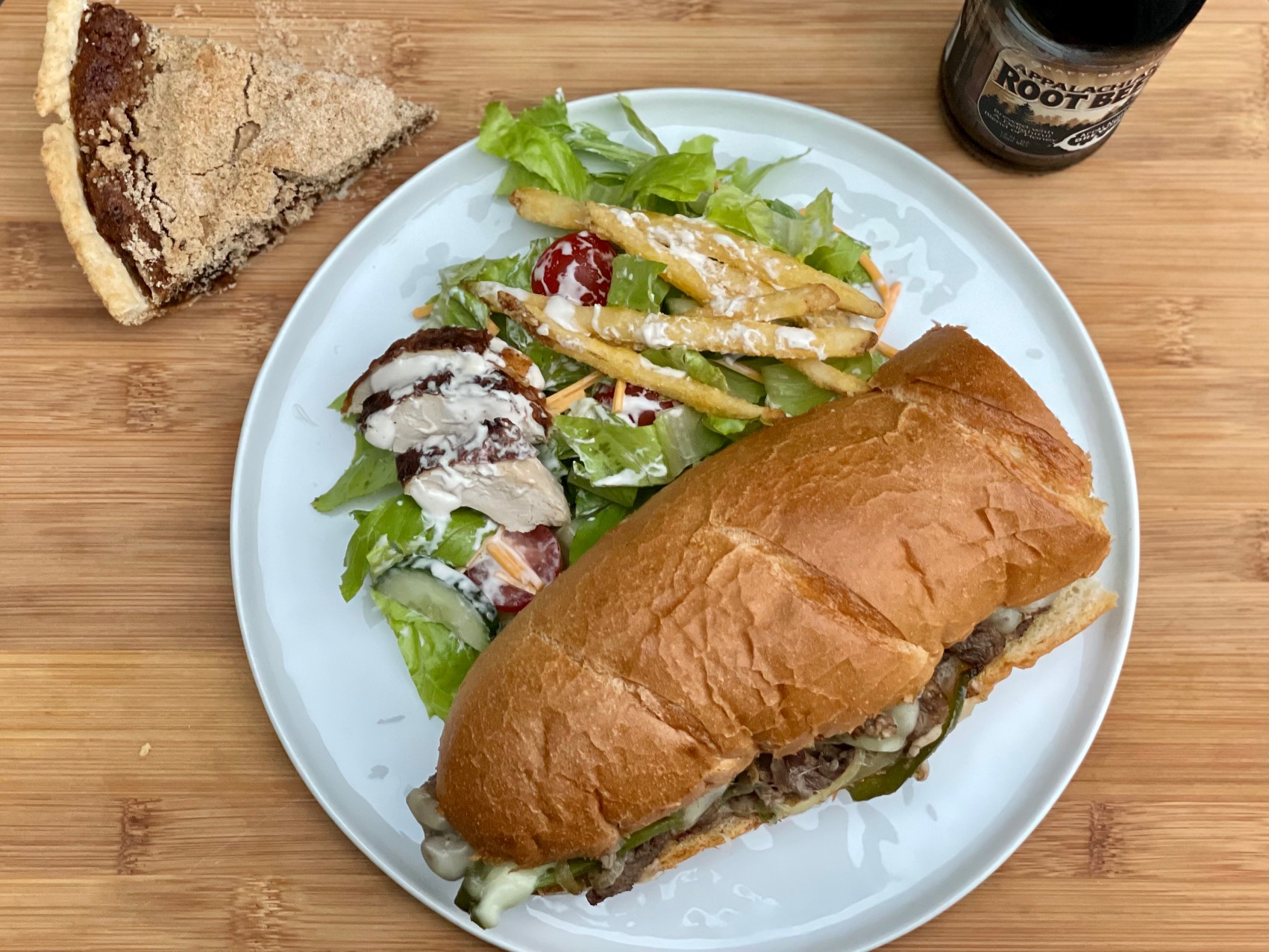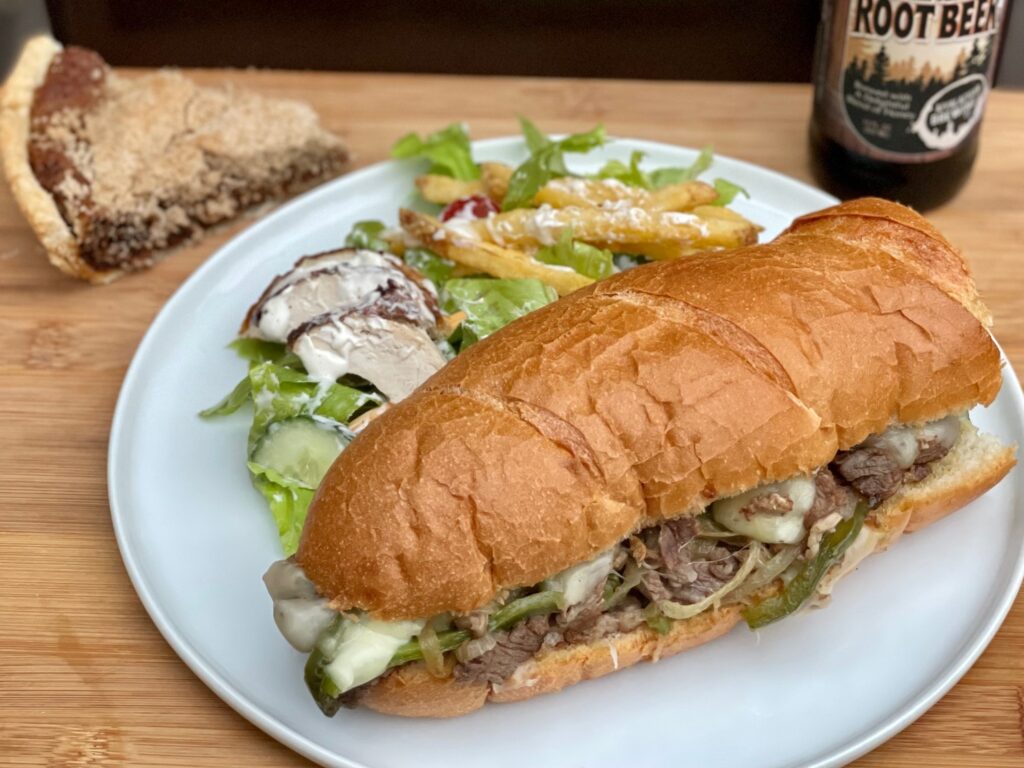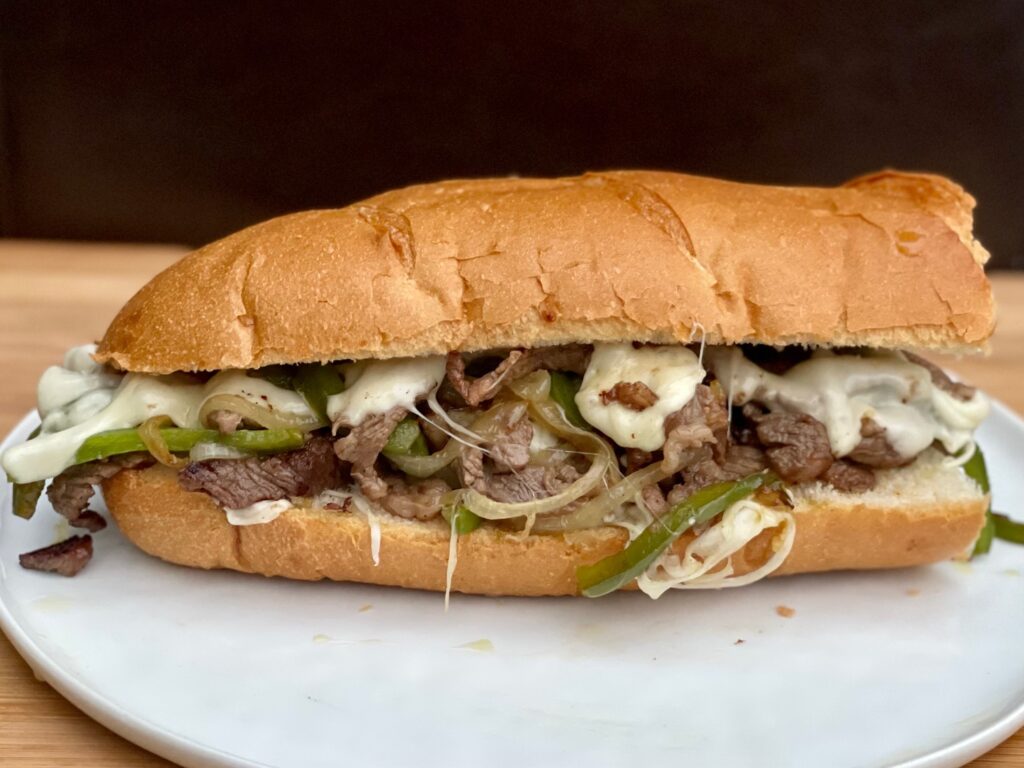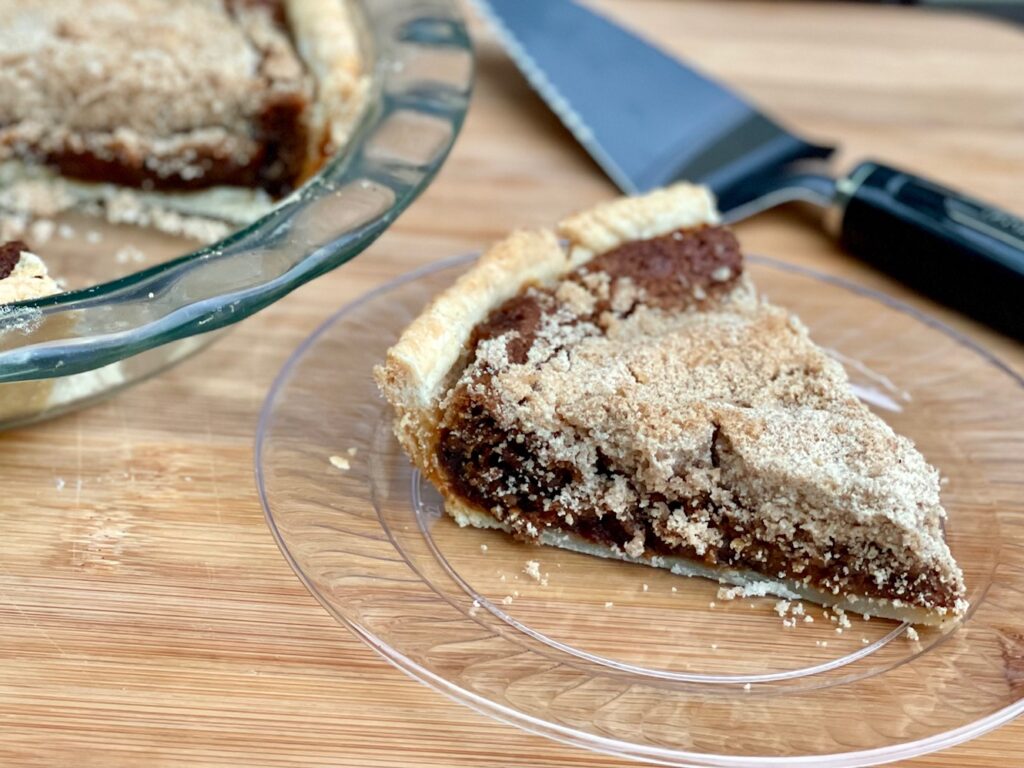Inspired by Pennsylvania

THE MEAL
(Click on the links above to jump to that part of the post!)
For this meal, I wanted to try to represent the different cultures of Pennsylvania while still sticking to well-known classics. Pennsylvania has a rich history—it was named after William Penn, who bought the land to provide a religious refuge for Quakers, and it quickly drew in others of various faiths seeking religious freedom. Philadelphia was essentially the nation’s capital leading up to the American Revolution and was where the Declaration of Independence was signed. Pittsburgh has long been an important industrial hub for coal mining and steel production. And, of course, the area was home to many Native American tribes long before Europeans came into play. I wanted to get a little of all that history into the meal, and I think I did an okay job.
PHILLY CHEESESTEAK SANDWICH
First of all, the main had to be a philly cheesesteak sandwich. This is definitely the first thing that people think of when they think of Pennsylvania food.
Invented in Philadelphia in 1930s, this sandwich is said to have originated when a pair of hot dog vendors named Pat and Harry Olivieri made themselves sandwiches with grilled beef and onions on their hot dog rolls. A passing cab driver asked for one, and soon the brothers had a huge following, leading them to create a new business called Pat’s King of Steaks, which still exists today! Later, a manager at one of their franchised locations added provolone cheese to the sandwich, and from then on it became known as a “cheesesteak.”
There are many variations on a Philly cheesesteak, but the main components are thinly-sliced grilled meat, grilled vegetables, melted cheese, and a hoagie roll. It’s not always steak—sometimes you can find them made with chicken. And while provolone cheese is considered traditional, the most popular cheese nowadays is Cheez Whiz or American cheese.
I decided to go the traditional route, using thinly sliced ribeye steak, green peppers, onion, and provolone cheese. After sauteeing the peppers and onions in butter, I browned the meat with a little worcestershire, then stirred the veggies back in and topped it all with provolone cheese, letting it sit until the cheese melted. I did forget the classic move of putting the open hoagie bun down on the griddle over the meat and cheese, then scooping it all up into the toasted bun the way they do at many cheesesteak places. I highly doubt it would have turned out as pretty if I’d tried that.
I don’t usually eat steak, but I loved this sandwich. The thinly sliced meat was so tender, and having it mixed in with the veggies and cheese made the perfect distribution. Every mouthful was great! The flavors are something between a burger and the fajitas my parents always make with green peppers and onion. It was delicious and rich and very satisfying, but definitely just a “sometimes food” for me. I probably will order a cheesesteak from a restaurant sometime soon, though, because this reminded me how good they are.
PITTSBURGH SALAD
While the cheesesteak represented eastern Pennsylvania, this salad is more common in western Pennsylvania. It’s a pretty normal salad for the most part—just lettuce, tomatoes, cucumbers, some grilled meat, and oh yeah, french fries! It’s something I’ve never seen before, but in Pittsburgh, this is just called a “steak (or chicken) salad”—having fries on top isn’t unusual enough to mention!
I had to laugh when I was looking into the origins of this salad. One story goes that someone ordered a steak sandwich without the bun, but with fries, and then added salad dressing. It reminds me of that Spongebob episode. Just remove the bun and, “Here you go. Two sa-lads.”
It was pretty good! I definitely like fries on salad better than croutons. I wasn’t really sure how to eat the fries with the rest of the salad, though, since they were longer than everything else, but I managed. It’s definitely the kind of thing you have to eat fresh, when the fries are recently cooked. I find cold fries really gross, so my leftovers weren’t nearly as good the next day.
I’m glad I tried this, though, if for no other reason than that it led me to discover that frozen, store-bought french fries are actually pretty good! The whole bag cost me about as much as a single large fry would have at a drive-thru. This is dangerous knowledge…
ROOT BEER
I didn’t take a photo of the root beer, because I didn’t end up making it from scratch. I wanted to, but didn’t have the time, and I couldn’t find root beer extract when I went grocery shopping.
But root beer has been around the Pennsylvania area for ages. Drinks made with root beer’s main flavor, sassafras, originated with the Native Americans. European farmers adapted their recipes to make non-alcoholic “small beer,” which became hugely popular as a family drink. Founding Fathers like George Washington, Thomas Jefferson, and Benjamin Franklin are said to have had favorite root beer recipes.
Root beer was first sold commercially in Pennsylvania in 1876 by a Philadelphia pharmacist named Charles Hires. His company started selling the root beer in bottles in 1893. So while Philadelphia isn’t really the birthplace of root beer, it is strongly associated with it.
Root beer was especially popular during Prohibition. Sassafras is still the primary flavor, but there are all kinds of variations nowadays, most of them sweet and fizzy. In my personal experience, root beer is considered a kids’ drink, and people make it from scratch to feed a crowd. It’s especially fun to make at Halloween time, when you can make it in a cauldron so the dry ice creates a creepy fog. That was what I had hoped to do for this meal, but I had too busy of a month to go through the effort, sadly. At least I bought a bottle to go along with this meal!
SHOOFLY PIE
A staple of Amish, Mennonite, and Moravian cuisine, nobody really knows who invented the shoofly pie. This dessert is apparently similar to a treacle tart in Europe (a dessert I was always curious to try after reading Harry Potter), and it was originally made as a cake, not in a pie crust, until the 1880s. Traditionally it was a breakfast food, eaten with coffee. (Not gonna lie, I ate a leftover slice for breakfast the other day…)
The name comes from the brand of molasses, “Shoo-fly Molasses,” which was named after a circus mule named Shoo-fly that toured Pennyslvania in the 19th century, who was possibly named after the song “Shoo Fly, Don’t Bother Me.” Another popular story is that flies need to be constantly shooed away because the pie is so delicious. In any case, I’ve had “Shoo Fly, Don’t Bother Me” stuck in my head for days.
This pie was a surprise hit for me. I had no idea what to expect going into it, and even as I was making it, I was sure it would turn out to be a disaster. The filling is made by alternating a very watery molasses liquid and a very powdery crumb mixture. It didn’t seem like it would cook well—it looked so liquidy and yet also too dry before baking. And I wasn’t sure about the flavors, either. How could molasses water and a bunch of crumbs result in a tasty pie?
Well, it turned out amazing! I definitely didn’t divide the crumb mixture enough and had too much on top, but the molasses water turned into a creamy, custardy bottom layer with the same scrumptious mouth-feel of pumpkin pie and the flavor of gingerbread. The crumbly bits gave it a little crunch and tasted like coffee cake. Reader, it was SO GOOD. Hats off to whatever genius came up with this dessert!

So how do you think I did? Let me know in the comments if you have any suggestions for improvement, and be sure to tune in next time for my take on a meal inspired by Ohio! If that’s where you’re from, what do you think I should make to represent your state? Bonus points if you have reliable recipes or pro tips before I make the attempt! Thank you for reading!



